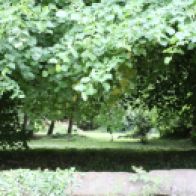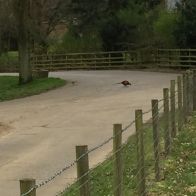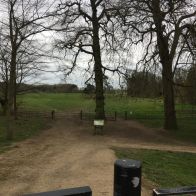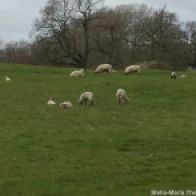May 2020 – Towcester to Hulcote, Northamptonshire
Sunday mornings since the lockdown began have taken on a pattern of their own, with breakfast at around 10, usually a poached or boiled egg, with toast while we listed to the radio, followed by grabbing a camera, and a raincoat and heading out for a walk. There are several suitable destinations within a short distance including Hulcote. I’ve been running up the road which used to be the main road to Northampton before the now-busy A43 dual carriageway was built, and is thus known as Northampton Road, now a quiet road into the old town centre. At the top of a long steady hill, the road forks, with one fork going right towards the tiny hamlet of Hulcote. In the early spring the verges are thick with snowdrops along there, and in the summer it’s shaded by mature trees which makes it a very pleasant route for a runner keen to avoid pedestrians and cars alike without roasting in the sun.

The road to the hamlet basically ends there in a large loop so there are very few cars to contend with, though there is a grain store which does attract the odd lorry, and the occasional delivery driver. The grain silo, glimpsed in the background, associated with Home Farm is a modern intrusion that negatively impacts the setting of the conservation area. Further research has told me that the houses there are in a style referred to as “Bricklayer’s Gothic”, all bar the old school and the Manor House. There seems to have been a settement on the site for a very long time, but he “Chapel Village” as it’s sometimes known, in its current form is rather more recent. There is a massive village green, with some splendidly mature oak trees, and around it sit eight cottages in two groups of four. They were built as an estate village for Easton Neston, which I have written about before.

It was the 3rd Earl of Pomfret who had them built, probably between 1800 and 1822, removing some farmhouses to do so, and although I can’t prove it, I have a suspicion that the new buildings may have been divided in two originally. They are pretty spacious if not, and it wasn’t a time when the working classes would have had a lot of space. In 1816 the trustees of the Hulcote Charity Estate set up and supported a school for the poor children of Easton Neston Parish and provided a schoolmaster. The school ran for around 100 years before it closed due to lack of funds and attendance, but the building still stands, alongside a small lodge, and next to what might be the last remaining phone box in Northamptonshire! It’s apparently an early example of a model village, and it owes its cohesion to the fact that it belonged to the Easton Neston estate until very, very recently. It means that the original designs have not been diluted or demolished. Certainly according to the papers I was able to find, almost all of the properties within the conservation area are listed including all the cottages, and the earlier Manor House.

The history of the village prior to this is more than a little obscure, though the Old Ehglish name elements suggest a Saxon settlement. Sadly there is no firm archaeological evidence, though there are some iron age finds, and a quern stone, perhaps prehistoric or Roman, was found but no one thought to write down the location where they had found it so it may or may not be from Hulcote. There is an Iron Age and Roman settlement to the north east of the parish and all srts of small finds gave come to light. Additionally there are some medieval settlement remains on the north side of the village green. Ploughing has brought to light lots of stone-rubble and brick, associated with post-medieval pottery, tiles, glass and bone that match to a map from 1806. There are also two rectangular fishponds, both now dry, which were linked by a shallow ditch. There is another ditch in the woodland on the right the lane coming into the village, and this is thought to be a Saxon ditch, possibly a boundary marker, though it should be noted that the first actual recorded mention of Hulcote is from 1086.

The council report that sets out the details of the listing of the village has this to say about the architecture as a whole: “The western side of the green comprises four, largely identical distinctive detached cottages all in brick. Along the southern edge lie four pairs of cottages broadly similar in appearance to the detached properties but with single storey flanking wings. Pevsner describes these houses as: ‘A group of eight very loveable and little funny houses along two sides of the green.’ These buildings are two storeys in height and are built directly onto the road facing the green. Notably these houses are largely unaltered and retain their original plan form, symmetry and original features which are important to their character and appearance individually and as a group.”

Across the way from them is one of the former main entrances to Easton Neston Estate, with two matching listed lodges either side of the road. There were five entrances which doesn’t surprise me because the lodges on Northampton Road include one that is named “Third Lodge”. I think it’s fair to say that the family that built Easton Neston had both delusions of grandeur and cash to splash! The access from Hulcote is now private, with signs to prove it, but does demonstrate Hulcote’s former links with the House and is an important feature of the history and design of the village. Also “a number of footpaths still exist that link Hulcote to the surrounding countryside and settlements. To the north a footpath runs to the site of the former nunnery at Showsley, to the south a footpath connects the village to Easton Neston House, and finally a footpath runs east-west connecting the village to the former railway and Shutlanger respectively”. So maybe another day for those.

Oh, and there are alpacas in the fields by the entrance to Hulcote now, along with two small shaggy ponies of a type that anyone who ever read a Norman Thelwell book will easily recognise. The alapacas even have their names on the gate – the ponies do not appear to!
Just for good measure, I’d like to leave you with a shortened version of the timeline of the town of Towcester, starting in AD 45:
- 45—Romans build the fortified garrison town of Lactodorum on the junction of Watling Street.
- 917—‘Tofeceastre’ attacked by an invading Viking Army. Watling Street becomes the border between Saxon Wessex and the Danelaw. The “burh of Towcester” was thought to have been previously fortified by King Alfred of Wessex’s son, King Edward the Elder of Wessex.
- 1066 or later—Motte and bailey castle constructed on eastern side of Towcester.
- 1130—Building of Bury Mount.
- 1170-1200—Late Norman “Transitional” church is built and is the basis of the plan of the present St. Lawrence’s church.
- c.1280—Benedict Caetani (also known as Gaetano) was Rector of St. Lawrence’s. Later elected Pope Boniface VIII at Naples on 23rd January 1295.
- 1470—Edward IV gave 40 square feet of stone from his quarry at Hanley in the forest of Whittelwood for building and repairing the steeple, church and churchyard at Towcester.
- 1483—Richard III confirmed grant by Edward IV for stone for church. (Baker p.328)
- 1544—Henry VIII granted bailiffs and inhabitants of Towcester two fairs – October and March.
- 1551—Church mill recorded (Baker)
- 1573 June 6th—Storm of rain and hail of 1.5 inches resulted in flooding which brought down six houses. One child drowned. (Baker p.322)
- 1574—Former Knight Templar’s Mill at dissolution of Hospital of St John of Jerusalem granted to Robert Dudley. Site of Mill not traced.
- 1575—Plague at Towcester.
- 1604—Thomas Shephard born in Towcester. He was a puritan preacher who emigrated to America and became the first chaplain of Harvard University.
- 1608—Plague in Towcester. Thomas Shephard was sent to Foscote to escape it.
- 1643, February—Prince Rupert plundered Towcester and neighbourhood, then proceeded to Warwickshire.
- 1643, August—A section of the Royalist Army was quartered at Towcester. The parliamentarian Newport Horse surprised Towcester one night, slew the sentinels and about 30 men, took two colours and twenty prisoners to Newport.
- 1643, November—Prince Rupert, based at Easton Neston, sent out a proclamation to all the local villages demanding labourers with shovels to fortify the town.
- 1643, December—Prince Rupert, having made Towcester very strong by constructing water filled ditches, moved to Oxford but left a strong force at Towcester.
- 1644 Jan 18—Royalists slighted the works at Towcester and abandoned the town to join the army at Oxford.
- 1646 January—Towcester was head quarters for Colonel Whalley’s Brigade of Horse.
- 1665—Plague hits Towcester.
- 1675—The Bell Inn (182 Watling Street) built with stabling at the rear.
- 1684—Charles II granted Sir William Farmer a weekly Tuesday market and 3 fairs to be held on the Feast of St Lawrence, Shrove Tuesday and the 22nd March.
- 1695—Thomas Bickerstaff of London, a native of Towcester, gave the 3 almshouses he had erected to the Sponne Charity. The almshouses stood beside the Silverstone Brook, and were demolished in 1970.
- 1707/8—Fire causes £1057 of damage.
- 1749 March 25th—Fire at the George Inn – boy with candle accidentally ignited straw and kicked the burning straw into a stable which within a few hours had spread to 36 houses. (Baker p.324)
- 1781—Jenkinson’s bank started on a site which was still a bank until around three years ago. Jenkinson was a silk merchant, linen draper and woolstapler.
- 1798—Here are annual horse races,. Easton Neston has very bad roads about it, particularly a considerable one from Northampton, through Towcester and Oxford to Bath.
- 1799—Authentic data stone on the Post Office building.
- 1800—Towcester had a theatre with a pit.
- 1837—Rough stone tramways were laid up the hills to north of Towcester to aid coach travel.
- 1838—The Towcester Gas Company was formed in 1837 and the town streets were lit by 35 gas lamps.
- 1851—National School built for £1100, average attendance 150.
- 1852—A Police Station was built with accommodation for an inspector and two constables. A Magistrates Court was also built.
- 1854—Cholera epidemic. Occupants of the dilapidated houses around the churchyard suffered greatly.
- c.1855—Thomas Ridgway, thought to be the tea magnate, offered to build houses for the poor if Lord Pomfret would provide the land. The first houses were built in Brackley Road. Later another 12 houses were built forming Queens terrace, followed by 14 houses forming Albert Terrace. Ridgway erected about 50 houses at a cost of £6-7000. Rents were 5% of outlay. Improved health, comfort and social conditions for the poor.
- c.1856—A sewer was built at cost of £400 at the south end of town to improve sanitary conditions after the cholera outbreak.
- 1864—Lady Palmerston cuts the first turf of the East and West Junction Railway at Towcester in August 1864.
- 1865 The Town Hall & Corn exchange was built at a cost of £3600.
- 1866—The Blisworth to Towcester railway line was opened and Towcester Station built. A large number of Roman coins were found during the construction.
- 1873—Towcester to Stratford on Avon railway line was opened.
- 1876—First horse race at Towcester, established by Her Imperial Majesty, The Empress of Austria, who was staying at Easton Neston.
- 1878—Maria Sophie of Bavaria, the last Queen of Naples (and Sisi’s sister) stayed at Park View.
- 1887—Ceremony of Cutting the First Sod of the Stratford-on-Avon, Towcester and Midland Junction Railway by Sir Thomas Fermor Hesketh, Bart.
- 1890—Towcester Grammar School reopened on the Brackley Road with 33 boys under headmaster Mr John Wetherell M.A..
- 1898—The town was supplied with water from Dockwell Mill reservoir. The Churchyard was enlarged by half an acre by Earl of Pomfret.
- 1901—Fire destroys Phipps and Co brewery at Towcester.
- 1921—The Hesketh Boot and Shoe Factory in Vernon Road was destroyed by fire.
- 1923—Towcester Grammar School destroyed by fire.
- 1925—Mains electricity laid in Towcester in about 1925.
- 1931—The Workhouse, built in 1836, was closed and taken into the ownership of Northamptonshire County Council.
- 1937—The Police Station was rebuilt.
- 1939—Towcester Cinema First Night on the 5th December 1939.
- 1948—Silverstone Aerodrome opened for motor racing.
- 1952—Mr Law was making sports shoes for Roger Bannister, Cheshire, All Blacks and Springboks.
- 1958—Passenger services from Towcester Railway Station ceased.
- 1965—Freight services from Towcester Railway Station ceased.
- 1984—Towcester Cinema was demolished after standing empty since 1974.
- 1987—The Towcester bypass (A43) opens.
- 2001—Grandstand at Towcester Racecourse (built in 1929) demolished.
- 2005—Contents of Easton Neston house auctioned by Sotheby’s.
- 2005—Lord Hesketh sold Easton Neston house and estate for £15 million to Russian fashion millionaire Leon Max.
- 2009—The 30 acre water meadow between Bury Mount and the River Tove was acquired by South Northamptonshire Council and the West Northamptonshire Development Corporation. It contains an important Iron Age ritual burial site of the Catuvellauni Tribe.
- 2009—Work starts on the restoration of Bury Mount (Towcester Castle) as part of the Moat Lane Regeneration Project.
- 2014, June 2014—Towcester Mill Brewery and Tap Room established at Towcester water mill.



















































































Those cottages are certainly generous. I wonder what the weekly rent was?
LikeLike
There’s so little information that I have no idea. They are very big and the “village green” is enormous!
LikeLiked by 1 person
Wow. Awesome post and wonderful photos! Snow drops is one of my favorite photos, but there are many others too.
Have a nice day!
LikeLike
Hello Stella.
Well made excellent post including wonderful photos! Thank you.
Have a wonderful day!
LikeLike